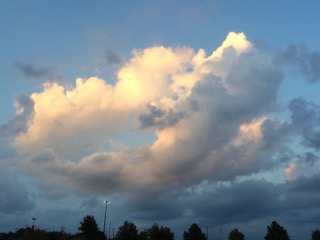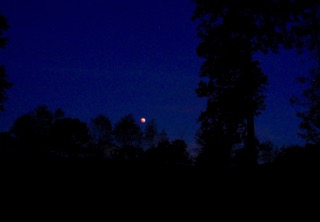by David O. Carrico, OD
The 2017 Solar Eclipse: Important Eye Safety
UPDATE: Loden Vision Eclipse Safety Glasses are out of Stock
We have given away over 10,000 pairs of safety glasses for the eclipse in less than two weeks! Unfortunately, our supply has run out at all locations. The turnout was phenomenal and we are so pleased we were able to support the public as much as we could during this historic event. It is incredibly important that you do not view the eclipse with your naked eye. Doing so could cause permanent, irreversible eye damage.
Please visit NASA’s website (https://eclipse2017.nasa.gov/safety) for more information on getting the proper eyewear from approved vendors. Not all vendors are the same when it comes to safety glasses. Be sure you are getting true ISO Approved Glasses with code number 12312-2 on the back from one of the NASA approved manufacturers. Look for Dr. Loden on News Channel 5 TV and their Facebook Live as well as on Fox 14 the week of August 14th and August 21 to hear important safety tips! We hope you enjoy the show!
As you might imagine, all of us here at the Loden Vision Centers are passionate about vision. There is nothing more satisfying than identifying a condition long before it becomes a problem, restoring someone’s vision after months or years of loss, or eliminating dependency on corrective eyewear.
Unfortunately, many people take their eyes for granted. They neglect their routine eye exams, purchase cheap dime-store readers, abuse their contact lenses, or use the string trimmer or chain saw without safety glasses. I often tell patients that folks with healthy eyes never think about their eyes until they have a problem; then they can’t think of anything else until it’s resolved! Those of you who’ve had a corneal abrasion or a wood chip under your eyelid know exactly what I mean.
Eyesight is one of our most important senses. Consider the wonders that quality eyesight brings to enhance your life: the vibrant colors of your flower garden, the breathtaking majesty of a mountain vista, the angelic faces of your grandchildren, or the silent beauty of a new-fallen snow. The list is endless.
For myself, some of my favorite visual experiences occur almost daily. Living here in Paris, I have a relaxed 7-minute commute to work. There is never any traffic to speak of and I enjoy the beautiful landscape as it progressively changes through the seasons. But what I like the most isn’t terrestrial; it’s heavenly objects which attract my attention. During the day, it’s the cloud cover that blows me away (pun intended). Clouds come in so many interesting forms. A ceiling of fish scales in cool grey, mauve and blue. Wispy feathers at the highest altitudes. Marshmallow clusters like the world’s most extravagant pillows, and the occasional towering thunderhead atop a soft curtain of rain.

There are days when the airline contrails divide the sky into geometric shapes, or the sun backlights a cloud to create a glowing corona. And who can ignore the natural Christian postcard when the sun spots an opening in the cloud cover and sends vivid beams toward earth? How about rainbows? I could also go on and on describing the gorgeous color variations at sunset. Blazing fire of brilliant oranges and golds, neon pinks and purples against a backdrop of baby blue. Stunning. The human eye can discern millions of colors, and some sunsets seem to cover the entire spectrum! One last thing. I love lightning as well, especially heat lightning. Once, I laid down in my driveway for half an hour on a warm spring night to watch a coming storm. The heat flashes were incredibly low and covered the entire sky. It was like a free fireworks show with God as the lighting director.
This leads me to the night sky, which is even better than the day. My love for stargazing surpasses my passion for watching the clouds. Paris, Tennessee has very little light pollution, and since my wife and I built a home outside of town, the night sky is even more dramatic. The constellations are fascinating, like Orion and his trailing dog, Canis Major, as well as others like Cassiopeia, the Dippers, and Cygnus the Swan. On a clear, moonless night, you can see that the stars come in many color variations. Most are brilliant white with a tiny shade of cool blue, others are warm and golden, and less frequently there are stars with a reddish cast. There are star clusters like the Pleiades, and planets cruise by throughout the year, if you know where to look. Years ago I bought an amazing 9-inch reflecting telescope, through which I’ve seen fuzzy distant galaxies, double stars, nebulas, and the rings of Saturn. Just last week I was able to see the 2 dark bands on the surface of Jupiter, with 4 of it’s moons! I also saw the Hale-Bopp comet back in ’97, and the Blood Moon in 2014, a haunting display of a Lunar eclipse.

This brings me to the actual point of my little dissertation. This upcoming summer, on Monday, August 21st, Tennesseeans will be dazzled by one of the most profound celestial events of all: a total solar eclipse, when the moon entirely blocks out the sun for a period of about 2 minutes. The entire continental United States will be treated to a partial version of the eclipse, but anyone within the path of totality (a roughly 70 mile-wide ribbon stretching from Lincoln Beach, Oregon to Charleston, South Carolina) will see the TOTAL eclipse.
Nashville, by chance, happens to be almost directly in the path of totality. Hopefully, the day will be clear and sunny. The eclipse begins in the Music City at 11:58am CDT and ends at 2:54pm. However, totality begins at 1:27 and lasts simply until 1:29. That’s a mere 2 minutes to witness one of nature’s most awe-inspiring events. During the eclipse, it will become so dark that bright stars and planets will become visible, and it’s been reported that the subdued light creates shimmering effects on the ground. It’s no wonder that ancient civilizations regarded a total eclipse as an omen to indicate an impending miracle, the wrath of God, or the doom of a ruling dynasty.
Of course, you must take extreme care to visualize the eclipse. You must NEVER look at the sun without certified eye protection, except for the brief period of totality. Do you remember the wild kid from your neighborhood growing up? The kid who showed you how to burn bugs using his magnifying glass? That same intense focusing power can occur in your eyes if you stare at the partial eclipse for any length of time. It’s called Solar Maculopathy, and if you burn the most sensitive center of your retina, the damage can become instantaneously permanent. See the chart below on viewing the phases of the eclipse.

Approved ways of viewing the eclipse involve projection techniques like a pinhole in paper or cardboard, which create an indirect image of the eclipse on the ground. A similar effect will occur naturally through all the small openings in the shadow of a tree. Telescopes equipped with a solar filter can be amazing, but one of the simplest and best ways to view the eclipse is with Certified Eclipse glasses or hand-held Solar Viewers, which meet ISO 12312-2 international standards for such products. Presently four manufacturers have certified that their products meet that standard: Rainbow Symphony, American Paper Products, Thousand Oaks Optical, and TSE 17. I recommend you go to the website eclipse2017.com and consider their glasses, which meet even the newest standards passed in 2015. One way or another, a total eclipse on a clear day can be a once-in-a-lifetime visual experience!
Finally, I will close with this thought. Over the years, I’ve noticed something interesting, and it’s this: as my patients get very old, their ability to look up gradually diminishes. A majority of the time this seems to hold true. It occurs, I believe, because we spend most of our life looking down. We watch our step and clean our plates and check our speed and wash our hands and tie our shoes and check our phones, right? Now don’t get me wrong, I think lots of “down-things” are great. But take my word for it, you can have yourself a great visual experience, day or night. All you have to do is… LOOK UP!
Pick up Your Free Eclipse Safety Glasses at Loden Vision
Loden Vision is proud to sponsor safety glasses for the Gallatin Eclipse Event and News Channel 5! You may pick up your eclipse safety glasses at our optical boutiques in Green Hills, Goodlettsville, Gallatin and Smyrna as well as at our Paris location. Quantities are limited and will be distributed on a first-come, first-served basis. Limit two pair per person. Glasses must be picked up in-person at one of our office locations. Tune in to Channel 5 News in the coming weeks to hear more about important eye safety during the solar eclipse from Dr. Loden!


